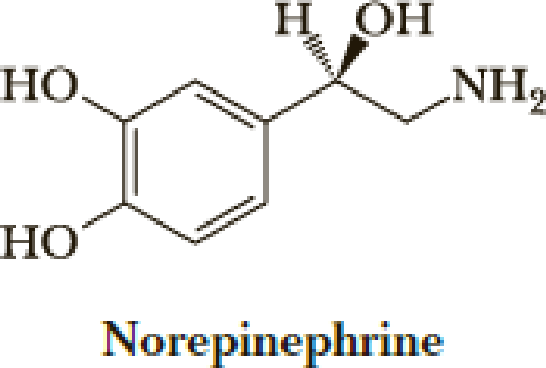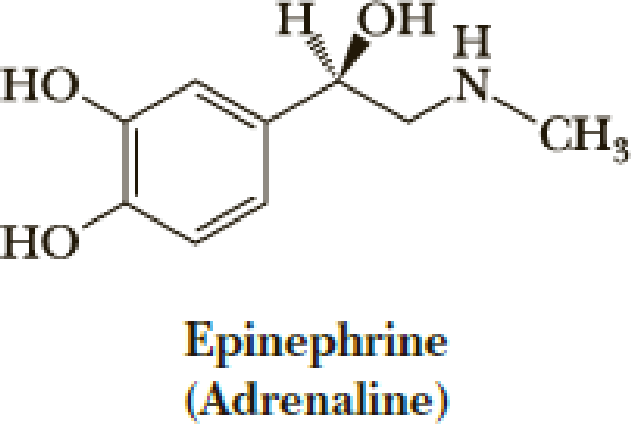
Organic Chemistry
8th Edition
ISBN: 9781305580350
Author: William H. Brown, Brent L. Iverson, Eric Anslyn, Christopher S. Foote
Publisher: Cengage Learning
expand_more
expand_more
format_list_bulleted
Concept explainers
Textbook Question
Chapter 27, Problem 27.21P
Both norepinephrine and epinephrine are synthesized from the same protein-derived amino acid. From which amino acid are they synthesized? What types of reactions are involved in their biosynthesis?


Expert Solution & Answer
Trending nowThis is a popular solution!

Students have asked these similar questions
Use the observations about each chemical reaction in the table below to decide the sign (positive or negative) of the reaction enthalpy AH and reaction entropy
AS.
Note: if you have not been given enough information to decide a sign, select the "unknown" option.
reaction
observations
conclusions
ΔΗ is
(pick one)
A
This reaction is faster above 103. °C than
below.
AS is
(pick one)
ΔΗ is
(pick one)
B
This reaction is spontaneous only above
-9. °C.
AS is
(pick one)
ΔΗ is
(pick one)
C
The reverse of this reaction is always
spontaneous.
AS is
(pick one)
18
Ar
Use the observations about each chemical reaction in the table below to decide the sign (positive or negative) of the reaction enthalpy AH and reaction entropy
AS.
Note: if you have not been given enough information to decide a sign, select the "unknown" option.
reaction
observations
conclusions
A
The reverse of this reaction is always
spontaneous but proceeds slower at
temperatures below 41. °C.
ΔΗ is
(pick one)
AS is
(pick one)
ΔΗ is
(pick one)
B
This reaction is spontaneous except above
94. °C.
AS is
(pick one)
This reaction is always spontaneous, but
ΔΗ is
(pick one)
C
proceeds slower at temperatures below
−14. °C.
AS is
(pick one)
Х
00.
18
Ar
무ㅎ
B
1
1
Draw the product of the reaction shown below. Ignore inorganic
byproducts.
+
H
CH3CH2OH
HCI
Drawing
Chapter 27 Solutions
Organic Chemistry
Ch. 27.1 - Of the 20 protein-derived amino acids shown in...Ch. 27.2 - Prob. 27.2PCh. 27.2 - Prob. 27.3PCh. 27.3 - Draw a structural formula for Lys-Phe-Ala. Label...Ch. 27.4 - Which of these tripeptides are hydrolyzed by...Ch. 27.4 - Deduce the amino acid sequence of an undecapeptide...Ch. 27.6 - Prob. 27.7PCh. 27 - What amino acid does each abbreviation stand for?...Ch. 27 - The configuration of the chiral center in -amino...Ch. 27 - Assign an R or S configuration to the chiral...
Ch. 27 - Prob. 27.11PCh. 27 - Prob. 27.12PCh. 27 - Draw zwitterion forms of these amino acids. (a)...Ch. 27 - Prob. 27.14PCh. 27 - Why is Arg often referred to as a basic amino...Ch. 27 - Prob. 27.16PCh. 27 - Prob. 27.17PCh. 27 - Prob. 27.18PCh. 27 - Prob. 27.19PCh. 27 - Prob. 27.20PCh. 27 - Both norepinephrine and epinephrine are...Ch. 27 - Prob. 27.22PCh. 27 - Draw a structural formula for the form of each...Ch. 27 - Prob. 27.24PCh. 27 - Write the zwitterion form of alanine and show its...Ch. 27 - Prob. 27.26PCh. 27 - Write the form of aspartic acid most prevalent at...Ch. 27 - Prob. 27.28PCh. 27 - Prob. 27.29PCh. 27 - For lysine and arginine, the isoelectric point,...Ch. 27 - Prob. 27.31PCh. 27 - Account for the fact that the isoelectric point of...Ch. 27 - Prob. 27.33PCh. 27 - Prob. 27.34PCh. 27 - At pH 7.4, the pH of blood plasma, do the majority...Ch. 27 - Prob. 27.36PCh. 27 - Prob. 27.37PCh. 27 - Prob. 27.38PCh. 27 - A chemically modified guanidino group is present...Ch. 27 - Draw a structural formula for the product formed...Ch. 27 - Prob. 27.41PCh. 27 - Prob. 27.42PCh. 27 - A decapeptide has the following amino acid...Ch. 27 - Following is the primary structure of glucagon, a...Ch. 27 - Prob. 27.45PCh. 27 - Draw a structural formula of these tripeptides....Ch. 27 - Estimate the pI of each tripeptide in Problem...Ch. 27 - Glutathione (G-SH), one of the most common...Ch. 27 - Following are a structural formula and a...Ch. 27 - Prob. 27.50PCh. 27 - Prob. 27.51PCh. 27 - Prob. 27.52PCh. 27 - Prob. 27.53PCh. 27 - Prob. 27.54PCh. 27 - Distinguish between intermolecular and...Ch. 27 - Prob. 27.56PCh. 27 - Prob. 27.57P
Knowledge Booster
Learn more about
Need a deep-dive on the concept behind this application? Look no further. Learn more about this topic, chemistry and related others by exploring similar questions and additional content below.Similar questions
- please explain this in simple termsarrow_forwardK Most Reactive Na (3 pts) Can the metal activity series (shown on the right) or a standard reduction potential table explain why potassium metal can be prepared from the reaction of molten KCI and Na metal but sodium metal is not prepared from the reaction of molten NaCl and K metal? Show how (not). Ca Mg Al с Zn Fe Sn Pb H Cu Ag Au Least Reactivearrow_forward(2 pts) Why is O2 more stable as a diatomic molecule than S2?arrow_forward
- Draw the Lewis structure for the polyatomic phosphite (PO¾³¯) a anion. Be sure to include all resonance structures that satisfy the octet rule. C I A [ ]¯arrow_forwardDecide whether these proposed Lewis structures are reasonable. proposed Lewis structure Is the proposed Lewis structure reasonable? Yes. :0: Cl C C1: 0=0: : 0 : : 0 : H C N No, it has the wrong number of valence electrons. The correct number is: ☐ No, it has the right number of valence electrons but doesn't satisfy the octet rule. The symbols of the problem atoms are:* ☐ Yes. No, it has the wrong number of valence electrons. The correct number is: ☐ No, it has the right number of valence electrons but doesn't satisfy the octet rule. The symbols of the problem atoms are:* Yes. ☐ No, it has the wrong number of valence electrons. The correct number is: ☐ No, it has the right number of valence electrons but doesn't satisfy the octet rule. The symbols of the problem atoms are:* | * If two or more atoms of the same element don't satisfy the octet rule, just enter the chemical symbol as many times as necessary. For example, if two oxygen atoms don't satisfy the octet rule, enter "0,0".arrow_forwardDraw the Lewis structure for the polyatomic trisulfide anion. Be sure to include all resonance structures that satisfy the octet rule. с [ ] - Garrow_forward
- 1. Calculate the accurate monoisotopic mass (using all 1H, 12C, 14N, 160 and 35CI) for your product using the table in your lab manual. Don't include the Cl, since you should only have [M+H]*. Compare this to the value you see on the LC-MS printout. How much different are they? 2. There are four isotopic peaks for the [M+H]* ion at m/z 240, 241, 242 and 243. For one point of extra credit, explain what each of these is and why they are present. 3. There is a fragment ion at m/z 184. For one point of extra credit, identify this fragment and confirm by calculating the accurate monoisotopic mass. 4. The UV spectrum is also at the bottom of your printout. For one point of extra credit, look up the UV spectrum of bupropion on Google Images and compare to your spectrum. Do they match? Cite your source. 5. For most of you, there will be a second chromatographic peak whose m/z is 74 (to a round number). For one point of extra credit, see if you can identify this molecule as well and confirm by…arrow_forwardPlease draw, not just describe!arrow_forwardcan you draw each step on a piece of a paper please this is very confusing to mearrow_forward
- > Can the molecule on the right-hand side of this organic reaction be made in good yield from no more than two reactants, in one step, by moderately heating the reactants? esc ? A O O •If your answer is yes, then draw the reactant or reactants in the drawing area below. You can draw the reactants in any arrangement you like. • If your answer is no, check the box under the drawing area instead. olo 18 Ar Explanation Check BB Click and drag to start drawing a structure. 2025 McGraw Hill LLC. All Rights Reserved. Terms of Use | Privacy Center Accessibilityarrow_forwardName the structurearrow_forward> For each pair of substrates below, choose the one that will react faster in a substitution reaction, assuming that: 1. the rate of substitution doesn't depend on nucleophile concentration and 2. the products are a roughly 50/50 mixture of enantiomers. Substrate A Substrate B Faster Rate X CI (Choose one) (Choose one) CI Br Explanation Check Br (Choose one) C 2025 McGraw Hill LLC. All Rights Reserved. Terms of Use | Privacy A F10arrow_forward
arrow_back_ios
SEE MORE QUESTIONS
arrow_forward_ios
Recommended textbooks for you
 General, Organic, and Biological ChemistryChemistryISBN:9781285853918Author:H. Stephen StokerPublisher:Cengage Learning
General, Organic, and Biological ChemistryChemistryISBN:9781285853918Author:H. Stephen StokerPublisher:Cengage Learning Organic And Biological ChemistryChemistryISBN:9781305081079Author:STOKER, H. Stephen (howard Stephen)Publisher:Cengage Learning,
Organic And Biological ChemistryChemistryISBN:9781305081079Author:STOKER, H. Stephen (howard Stephen)Publisher:Cengage Learning, Chemistry for Today: General, Organic, and Bioche...ChemistryISBN:9781305960060Author:Spencer L. Seager, Michael R. Slabaugh, Maren S. HansenPublisher:Cengage Learning
Chemistry for Today: General, Organic, and Bioche...ChemistryISBN:9781305960060Author:Spencer L. Seager, Michael R. Slabaugh, Maren S. HansenPublisher:Cengage Learning Organic ChemistryChemistryISBN:9781305580350Author:William H. Brown, Brent L. Iverson, Eric Anslyn, Christopher S. FootePublisher:Cengage Learning
Organic ChemistryChemistryISBN:9781305580350Author:William H. Brown, Brent L. Iverson, Eric Anslyn, Christopher S. FootePublisher:Cengage Learning Introduction to General, Organic and BiochemistryChemistryISBN:9781285869759Author:Frederick A. Bettelheim, William H. Brown, Mary K. Campbell, Shawn O. Farrell, Omar TorresPublisher:Cengage Learning
Introduction to General, Organic and BiochemistryChemistryISBN:9781285869759Author:Frederick A. Bettelheim, William H. Brown, Mary K. Campbell, Shawn O. Farrell, Omar TorresPublisher:Cengage Learning ChemistryChemistryISBN:9781305957404Author:Steven S. Zumdahl, Susan A. Zumdahl, Donald J. DeCostePublisher:Cengage Learning
ChemistryChemistryISBN:9781305957404Author:Steven S. Zumdahl, Susan A. Zumdahl, Donald J. DeCostePublisher:Cengage Learning

General, Organic, and Biological Chemistry
Chemistry
ISBN:9781285853918
Author:H. Stephen Stoker
Publisher:Cengage Learning

Organic And Biological Chemistry
Chemistry
ISBN:9781305081079
Author:STOKER, H. Stephen (howard Stephen)
Publisher:Cengage Learning,

Chemistry for Today: General, Organic, and Bioche...
Chemistry
ISBN:9781305960060
Author:Spencer L. Seager, Michael R. Slabaugh, Maren S. Hansen
Publisher:Cengage Learning

Organic Chemistry
Chemistry
ISBN:9781305580350
Author:William H. Brown, Brent L. Iverson, Eric Anslyn, Christopher S. Foote
Publisher:Cengage Learning

Introduction to General, Organic and Biochemistry
Chemistry
ISBN:9781285869759
Author:Frederick A. Bettelheim, William H. Brown, Mary K. Campbell, Shawn O. Farrell, Omar Torres
Publisher:Cengage Learning

Chemistry
Chemistry
ISBN:9781305957404
Author:Steven S. Zumdahl, Susan A. Zumdahl, Donald J. DeCoste
Publisher:Cengage Learning
DIGESTER-35 | VITAMINS AND THEIR RELATED COENZYMES| GPAT | NIPER | PHARMACIST| DI; Author: GPAT DISCUSSION CENTER;https://www.youtube.com/watch?v=CGrdNYmho0s;License: Standard YouTube License, CC-BY